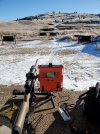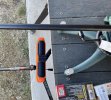As with others, I set the unit up well behind the muzzle, both for blast reasons as well as reaching controls.
I do believe there is some minor (hair splitting?) "geometry" influence in the readings though, which is accounted for in the settings for rifle distance from the muzzle (6", 12", 18"). I believe this is to account for the variation in "straight line distance" caused by the offset. Pythagorean theory and all that, the same as when shooting up or down hill (line of sight vs horizontal distance).
By defining the offset, the radar can account for that extra little distance the microwaves have to travel on the round trip from the radar to the bullet and back.
For reference...
| Left/Right of Bbl (in) | Bullet to Bbl (yds) | Bullet to Radar (yds) | % Dif | Velocity difference at 3000 fps |
6 | 10 | 10.00139 | 100.01% | 2999.58 |
12 | 10 | 10.00555 | 100.06% | 2998.33 |
18 | 10 | 10.01249 | 100.12% | 2996.26 |
It should also be noted, that the difference between "bullet to bbl" and "bullet to radar" will change (decrease) as the bullet travels down range.
As you can see the variation is pretty small, but the math is pretty straightforward, so it's cool that the LabRadar software has an option to account for it. Minimize error when you can, right?
Since LabRadar calculates velocity based on the change in return time from reading to reading, the absolute distance the unit is behind the bullet doesn't matter, only the perpendicular offset from the bullet's line of travel, so how far back or forward you set the unit shouldn't matter, only how far off to the side.
Also, if you always set up your radar the same, then this should only affect the accuracy of your readings, and not the precision, as the error will be the same from shot to shot.




